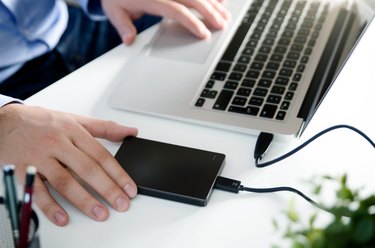
If you're using an external hard drive that was attached to another computer, you may encounter permissions issues where you can only read the drive's contents or have issues accessing its files. You might also want to change the permissions other computer users have so they can't make changes to the drive or simply restrict guest users from accessing the drive's contents entirely. As long as you have administrator credentials, you can edit external hard drive permissions on your Mac. However, if the drive was previously used with Windows, you may have to do some extra work to prepare it for read and write access.
Basics of Mac File Permissions
Video of the Day
Permissions on a file, folder or entire hard drive determine who has access and what actions they can perform. You can give users and groups permission to only read or only write to the external drive, or you can allow full access to read and write. You can also take away access to items entirely, which is helpful if you want to lock a folder on the Mac for security purposes.
Video of the Day
Permission options for hard drives can vary by user type. For example, Mac OS doesn't have the "no access" option available for user and administrator accounts, but you can use that option for the "everyone" group, which includes guest accounts. Mac user and administrator accounts are part of the "staff" group and can have read-only, write-only or read and write access to external hard drives.
Changing Permissions on External Drives
With the external hard drive connected to your Mac, right-click the drive's icon on your desktop and choose "Get Info" to see details about the drive. At the bottom of the drive info window, click the golden padlock if it appears locked, and then enter your Mac administrator password to unlock the permissions settings for the drive.
Under "Sharing & Permissions," you'll see a list with your user account name and the staff and everyone groups with their current permissions. Click the drop-down menu beside the account name or group whose permissions you want to change and then select the privilege you want to give them. For example, if you want all users and administrators to have read and write access to the external hard drive, you'd give "Read & Write" permissions to the "staff" group. Alternatively, you can choose to give only your account read and write permissions. To keep guests from accessing the drive, you'd set the permissions to "No Access" for the "everyone" group.
After updating the external drive permissions, click the gear icon below the permissions list and select "Apply to enclosed items" to prevent permissions conflicts. This setting will transfer the drive-level permission you just set to all files and folders on the drive. If you decide you want to restrict actions for certain files or folders, you can right-click those specific items, select "Get Info" and edit their permissions as you did for the drive as a whole.
Fixing Read-Only Drive Issues
If your external hard drive shows as read-only and Mac OS does not allow you to change the permissions, the problem may be that your drive uses the NTFS file system made for Windows. While you can still access files on the drive, Mac OS does not natively include support for writing to NTFS formatted drives. Your options include using a third-party tool like Tuxera NTFS for Mac that adds read and write functionality to such drives or reformatting your external drive to use a fully compatible file system.
If you choose to reformat, you'll want to first back up your external drive's data to another drive using a tool such as Time Machine. You can then launch Mac's Disk Utility, right-click the external hard drive in the list and then select "Erase" to change the drive to a format such as Mac OS Extended. You can then copy your files back over and set the desired permissions for the external drive.